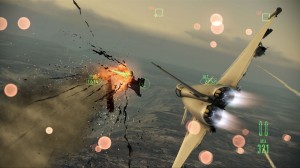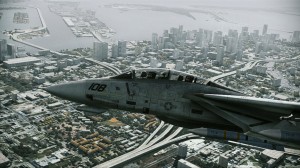Ace Combat: Assault Horizon – Hands-On Preview (360)
- Updated: 23rd Aug, 2011
 After watching all the cool-looking trailers I finally got play Ace Combat: Assault Horizon recently and I was more than a little excited. I wanted to check out the aerial combat parts and was keen to see how it holds up as a flight simulator because in my free time I get to fly real planes. Unfortunately, my planes aren’t the ones with jet engines and missiles. Not yet, anyway.
After watching all the cool-looking trailers I finally got play Ace Combat: Assault Horizon recently and I was more than a little excited. I wanted to check out the aerial combat parts and was keen to see how it holds up as a flight simulator because in my free time I get to fly real planes. Unfortunately, my planes aren’t the ones with jet engines and missiles. Not yet, anyway.
With joypad in hand and headphones in place I took control of an Lockheed Martin F-22A Raptor fighter jet in the midst of a full scale air assault above Miami. Right from the start I experienced one of the game’s big new features; close-range assaults or dogfight mode. Once I’d flown close enough to an enemy plane, tapping Left Bumper and Right Bumper together locked me into the close-range assault mode. If I were in a real plane, I would have been able to literally smell the jet fumes from the enemy aircraft’s engines, they were so close. Well, I could until I blasted his aircraft out of the sky using a combination of my machine gun and missiles. Keeping the enemy in sight long enough to get a missile lock whilst avoiding all the ground or air-based obstacles was a lot of fun. This games takes the Top Gun movie or Afterburner arcade game approach to air combat. I had smouldering bits of aircraft fuselage splattering all over my screen as I flew though his fiery death. Utterly brilliant.
A Pilot’s Perspective
As this is an action arcade flight simulator the controls are pretty basic for flying a jet aircraft. I was using the “optimum” (aka default) control scheme which prevented my F-22A from performing full, 360 degree rolls in the air. Using this control scheme the Left Stick controlled pitch and roll (i.e. up/down/left/right) Left Trigger activated the air brakes, Right Trigger adjusted engine power, A button fired the machine gun, B button fired missiles, Left Bumper and Right Bumper controlled the left rudder and right rudders respectively. I was also using the behind-the-aircraft view allowing me to see of all the aircraft’s control surfaces in action (i.e. ailerons and rudders).The head-up display (HUD) showed my airspeed, altitude, attitude indicator and the status of my weapons on screen. The HUD also highlighted other enemy and friendly aircraft, along with other points of interest like ground targets. All standard stuff. Now that I’d won my first dogfight I was able to explore the scenery and check out the aircraft’s handling characteristics.
As far as the mission weather was concerned there were a few clouds at 4,000 feet with 10 kilometers or more of visibility. Almost perfect conditions for flying. I reached the maximum in-game altitude of 40,000 feet in no time with full afterburners powering me high into the troposphere. At this altitude I could see vast swathes of the city of Miami stretching far into the distance. It was quite impressive. Incidentally the real-life service ceiling for the F-22A is reported to be 65,000 feet, so the game was quite a bit off being completely authentic.
Once I’d flown closer to the ground (about 39,940 feet closer thanks to a vertical dive), I followed a few roads and freeways and flew through some palm trees for kicks. The scenery stands up well under close inspection as real satellite imagery has been incorporated into the game, alhough none of the foliage is solid. You can fly through it all if you are low enough. The game does allow you to fly around gawping at the pretty scenery if you want to.
I wasn’t able to test the landing characteristics of the aircraft at any point during the mission. Instead my plane crashed and burned onto the runway. Not the kind of landing someone would walk away from and certainly not one that would impress my flying instructor.
The F-22A itself was far more responsive and quicker that anything I’ve flown in real life. It can perform steep turns at anything up to 90 degrees without developing a potentially lethal spiral descent. The F-22A has excellent departure resistance making it extremely difficult to force the aircraft from controlled flight despite aggressive control inputs from me as the pilot. I was able to quickly scrub airspeed, side-slipping the aircraft through the air by applying opposite rudder to the direction of the ailerons. This meant I was flying the aircraft sideways through the atmosphere. I was restricted in how much side-slipping I could perform so the aircraft wasn’t totally sideways, but it still was a extremely effective way of quickly dumping airspeed. Once I’d got my airspeed approaching 100 knots aircraft entered a deep stall and plummeted towards the ground. Of course, applying full power and raising the nose resolved that little issue. For new pilots the flight assistance options includes automatic stall prevention allowing you to concentrate on the air combat rather than the nitty gritty of flying and avoiding stalling the aircraft in mid-air.
Ace Combat: Assault Horizon also features MH-60 Blackhawk and AH-64D Apache Longbow helicopters to pilot as well as the F-35B Lightning II aircraft. The full game also includes Bomber missions which involve you taking out loads of ground-based targets using your finest targeting skills.Summary
The F-22A is a remarkably nimble and stable aircraft in flight, which is hardly surprising when you see it in action during the intense close-range assault mode. I felt totally at ease flying between skyscrapers to chase down enemy aircraft. The nicely detailed environments along with the inclusion of aspects of real flying such as the mechanics of the aircraft help generate a feeling that you are flying it for real. Ace Combat: Assault horizon provides an adrenaline filled flying experience, perfect for all wannabe jet fighter pilots.
Ace Combat: Assault Horizon is due for release on the 14th October 2011 for PlayStation 3 and Xbox 360.



Follow Us!